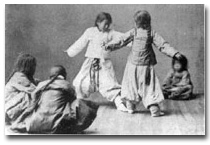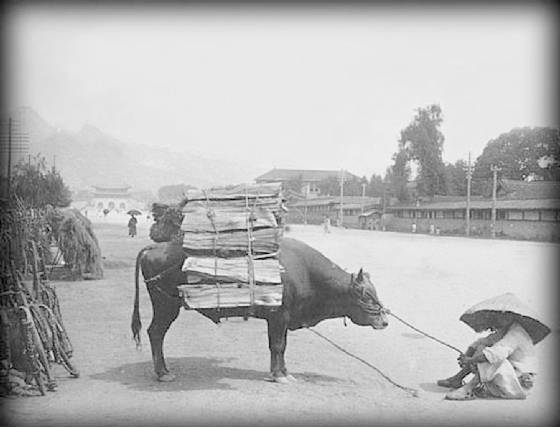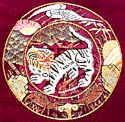|
|
 |
|

HanBok is the tradition style of clothing
that represents Korea.
Koreans use “ot”
as a general term for clothing. Traditional clothing and adornments, on the other hand, are called “hanbok” an
abbreviation of the term Han-guk pokshik (Korean attire).
In multiethnic nations such
as China and America,
styles of traditional attire are diverse. Korea however has a single ethnic group; consequently, traditional dress is synonymous
with national dress. For this reason, hanbok has always been an effective expression of Korean identity. Changes in hanbok
design from the past to the present parallel the nation’s historical development. Moreover, hanbok’s form, materials
and designs provide a glimpse into the Korean lifestyle, while its colors indicate the values and world view of the Korean
people.
Ancient History
During the Three Kingdoms period,
which began with the founding of Koguryo, (about 37 B.C.) hanbok consisted of a two-piece "unisex" outfit. The upper garments
of this period opened in front and came down below the waist. They were held shut with a belt. The lower garments were also
tied off above the feet. Notably, the opening flap of the upper garments seems to have been placed on a leftward diagonal
from the upper right, in contrast with the left to right flaps on the chogori worn today. This change in the direction of
the opening flap occurred after the mid-Koryo period. Among Western apparel, a right-side flap is used for male attire, while
a left-side flap is used for female attire. Thus, the unisex style popular in the modern period can be said to have originated
in East Asia, whereas the differentiation between male and female attire is thought to have
originated in the West. Ancient Koreans produced upper and lower garments which were beautiful yet practically suited to the
active lifestyle of nomadic hunters.
|
 |
|
Silla Dynasty
698 - 926

During the Shilla period, Korean
society diversified while contacts with neighboring countries increased. At this time, Koreans began to introduce the international
fashions of China's Tang Dynasty. Examples include sleeveless shirts for women, long scarves,
decorative hairpins, male headdress and coats with roung lapels. Elaborate silk clothing and ornaments were other elements
of the refined clothing fashions of the period.


| Late Chosun official |

|
|
 |
 |
 |
Koryo Dynasty
936 - 1259
During the Koryo period, the
long upper garments of the previous period gave way to waist-length attire. As a result, waist belts were replaced by coat
tie-strings. As one of the unique features of Korean clothing, the coat string was initially a short, thin cord but eventually
developed into the style seen today, i.e., a long, dangling piece of cloth that hangs down below the knees. Around this time,
Tang Dynasty's fashions became less influential. As Korean society turned to the values of frugality and simplicity, the calm,
tranquil beauty of agriculture life found expression in the period's famous blue celadon and white clothing. Korean clothing
underwent further refinement as cotton was introduced into Korea from Yuan China. In addition,
clothing regulations were introduced from abroad and a system of official uniforms was established for the palace.
| Late Chosun mailman |

|
| Late Chosun customs officer |

|
|
 |
 |
 |
|
Choson Dynasty
1392 - 1905
The beginning of the Choson period saw the
development of a Confucian society. At this time, the use of cotton became wide-spread. In addition, the period saw the development
of a unique script, known as Han-gul, and the publication of numerous scholarly compilations. At the same time, there were
diverse developments in the system of ritual attire. Confucianism, as the central ideology and faith of East Asia, was actively pursued
at this time, along with its system of ritual dress. Ritual clothing represented the visible manifestation of intangible Confucian
virtues such as benevolence, propriety, wisdom and trust. Since clothing served as a medium for the visible expression of
a rite, it was deemed a very significant form of expression. Hence, Choson apparel, in addition to its role in delineating
social status, represented a strict conformity to Confucian codes of ritual attire. In particular, a standardized system of
clothing for the various rites of passages was established in accordance with numerous ritual manuals. Special attire was
worn for the rites of manhood, marriage, mourning and memorial services. Even today, these clothes can be seen at weddings
and funerals, and in particularly conservative areas, the special clothing for memorial services is still worn. The traditional
dress of Confucian scholars can be seen in the paintings of the famous Choson folk painter, Shin Yun-bok. In these paintings,
the outer robes are long, yet never touch the ground. Inside the robes, multiple layers of undergarments can be seen. With
wide sleeves hanging down, the grave-looking scholar sports a broad-rimmed, horse-hair hat.
Late Chosun Dynasty
Though partly influenced by Japan,
people kept the traditional styles in many ways.
For amazing photo collections of late Chosun dynasty see:
Naver.com
구한말
더많은 이미지 보기
For late Chosun dynasty photos, click here.
|
 |
|
|
|
|
 |
|
| Late Chosun - Children playing |

|
| Farmer waiting |

|
Japanese Colonial Period
During this time, Korean women usually wore a long black skirt called "Chima" with a white
jacket called: "Chogri." The ties, called Korum varied in width and length. It was not unusual for woman of that
day to also wear a Jangdo, or short knife to be used for defense or suicide should one of the colonizers attempt to assault
their virtue.
1960s and the Miniskirt!
Yun Bok-hui was a singer in the 1960s that first popularized the miniskirt in Korea. Naturally, at
first she was considered quite crazy, but, before long, she'd started a trend that continues to this day. Hats off to
the courageous lady that started it all, Yun Bok-hui!

Modern developments
& the hanbok
Following
the Korean War (1950-53), a modernization campaign was undertaken. As a result, by the 1970’s the hanbok went out of
fashion and was replaced by Western-style dress. Thus, what was once an everyday casual outfit was relegated to the closet,
coming out only for weddings, holidays, and other special occasions.
In more recent times, however, the hanbok has been making a comeback. In 1996, for instance,
an effort was made to repopularize the style when the first Saturday of every month was declared to be “the day to wear
hanbok.” Clothing manufacturers introduced new hanboks especially designed to appeal to youths. Evidently there is something
emotionally satisfying about returning to one’s roots, for the modern hanbok has met with great success. In an era when
many of the latest styles emphasize sensuality, the hanbok is a refreshing example of beautiful and modest dress.

HISTORY OF EMBROIDERY
in EAST ASIA
Painting with a Needle: Learning the Art of Silk Embroidery
with Young Yang Chung by Young Yang Chung
Book Description
In this
gloriously illustrated book, master embroiderer Young Yang Chung shows readers how to "paint with a needle"--embroidering
in silk using centuries-old East Asian techniques and traditions. A world-renowned artist and gifted teacher, Young Yang Chung
provides detailed step-by-step instructions for 19 original projects--ranging from wall hangings to a cell-phone case--that
are suitable for all levels from beginner to advanced. The full-color photographs of centuries-old pieces that demonstrate
the various stitchery techniques are of such fine quality that Painting with a Needle stands as an art treasury as well as
a "how-to" book.
In her fascinating text,
Chung takes readers on a journey through time as she places silk embroidery in an East Asian historical and sociological context.
Tips on how to get started, including the types of tools and materials required, a list of suppliers, a section on starting
and finishing methods, and a glossary of embroidery terms in three languages (Chinese, Korean, and Japanes) make this the
ultimate book on silk embroidery.
About the Author
Young Yang Chung, world-renowned master embroiderer, was born
and raised in Korea, where she founded The International Embroidery School
and established Korea's first vocational
embroidery center. She now lives in the United States, dividing her time
between New York City and Larchmont, New York. Marie Campbell is President of The Embroiderers' Guild of America.

Feedback, submissions, ideas? Email greg_brundage@yahoo.com
|
|
|
 |

